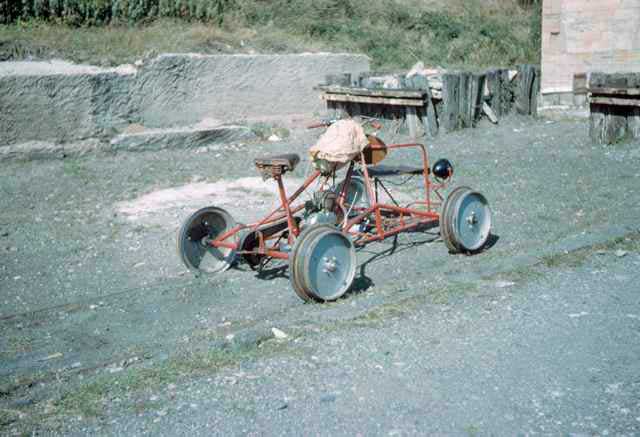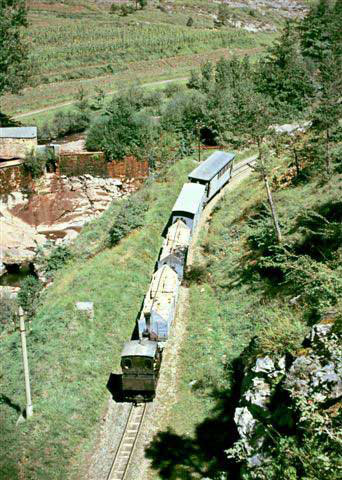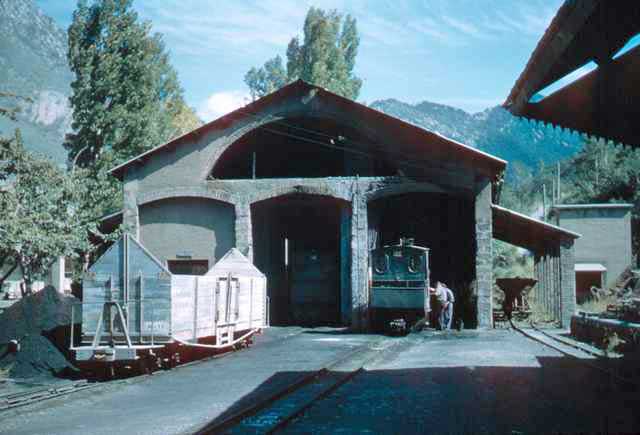PREVIOUS STEPS
When at the end of the last century the later Count Güell, Eusebi Güell i Bacigalupi, implemented his idea of operating a cement factory with a totally different concept from what had been done up to that time, importing the idea of manufacturing cement in rotary kilns from North America, he first encountered little support from the financial network.
Once the necessary support was obtained, the company General de Asfaltos y Portland (Asland) was created. From then on, it was necessary to look for the ideal place to locate the factory, and it turned out that one of the founders and member of the board of directors, Joaquim d'Abadal i Calderó, had a piece of land in the municipality of Castellar de n'Hug with important stone deposits. Then, after analyzing the high quality of the stone, it was decided to use it for the manufacture of Portland cement. The obvious problem was that it was far from the existing production centers.
This place, called Clot del Moro, had an important handicap: the Llobregat River could provide an important waterfall that would generate the 2,500 horsepower needed for the manufacture. Perhaps this was the fundamental reason for the installation of the factory in that place, and thus build the first cement factory in the country.
The main problem that arose from this point on was that the manufactured product could not be transported to the market in the usual way due to the precarious road infrastructure.
OPTIONS
As in most of the territories far from the big cities, Castellar de n'Hug was very poorly communicated by road, and therefore the transport had to be done by wagons on dirt roads that did not offer many guarantees of weight transport. In addition, at that time there were only two options for transporting the final product to the train, the first and most feasible was to unload in Olván so that the metre gauge railroads from Manresa to Olván could take charge of the transport using the Llobregat river valley, and the other was to cross the pre-Pyrenees to reach the broad gauge station of Ripoll, belonging to the San Juan de las Abadesas railroad, which served a coal mining basin. Both were about 30 kilometers apart.
In 1904 the situation changed radically towards the first option, given that the railroad that reached Olván would extend its route to Guardiola de Berguedà. Thus the steam tramway from Manresa to Berga was the best option for transporting the cement production of Clot del Moro.
Then, the traffic had to be carried out with horses from the factory to Guardiola, but there was a problem with the amount of load, which could not exceed 2 tons, so the company Asland took charge of the arrangement of the transversal road from Solsona to Ribas de Fresser in the section between Guardiola and La Pobla, and then another road that would join the aforementioned with Castellar de n'Hug.
TRANSPORTATION PROJECTS
Given the capacity and time limitations of the horse-drawn carriages, several options for higher capacity transport were considered. Despite the fact that a road had been built, expectations were initially placed on extending the route of the tramway from Manresa to Berga as far as Castellar de n'Hug, which was rejected at first by the company for not offering sufficient business volume. The second was to make the exit to the other side, towards the valley of the Fresser from La Pobla to Campdevànol, a study was made between 1903 and 1094, but it was excessive due to the topographic complication, which made the project to be reconsidered as an electric tramway. The third project was the construction of an aerial tramway with cables, which was underestimated due to its high cost.
LOCOMOBILE
In spite of the alternative projects were contemporary in time, already in 1902 a locomotive or steam road train was bought from an American factory in California, which was named after its manufacturer, Best. The locomotive of 15 Tm of weight and six wagons of 18 Tm of maximum load, always had the Berguedà region very impacted, having many oppositions. The official ones were based on official tests of a correct operation, but the particular ones were of frontal rejection. Thus the transport of pieces to the factory with the locomotive had many inconveniences.
On July 25, 1904 the Clot del Moro factory was solemnly inaugurated and in August it was already producing cement. Until the aforementioned inauguration of the tramway from Manresa to Berga from Olván to Guardiola, the locomotive used with reservations the railroad grade for transport, then by road to Castellar de n'Hug. Soon came the setbacks, since the General Directorate of Roads withdrew the locomotive's permission to circulate on the road under the pretext that it was damaging the road surface.
CARRIAGE
The prohibition caused a radical change of direction in the transportation of the factory's production, which meant a return to animal carting. For this purpose, 60 mules and different transport carts were acquired. Transport from the factory to Guardiola de Berguedà was resumed. But as the road was not very well consolidated, it would soon end up chipping due to the intense carting it had to endure. All this led the company and the Directorate of Public Works to the solution of laying a Decauville type track next to the road.
INDUSTRIAL TRAIN
 In 1906, and due to various inclemencies that prevented the rapid implementation, the railroad service began with a 600 mm. gauge, sleepers set at 75 cms. and rolling stock purchased from Arthur Koppel and Liebrecht in Germany. The legalization of the line came some time later due to the fact that it was being graded on public land. Therefore first the occupancy permit was given, but Asland already applied for a permit for a secondary railroad according to the Secondary Act of 1904. The motive was to seek the good for the county, since in this way the train was used for passenger transport as well. Thus we have that at first the railroad facilities were those of an industrial train with locomotive and wagons that did not ensure a heavy traffic. The rail used was of the Vignole type of 12 kg/m.
In 1906, and due to various inclemencies that prevented the rapid implementation, the railroad service began with a 600 mm. gauge, sleepers set at 75 cms. and rolling stock purchased from Arthur Koppel and Liebrecht in Germany. The legalization of the line came some time later due to the fact that it was being graded on public land. Therefore first the occupancy permit was given, but Asland already applied for a permit for a secondary railroad according to the Secondary Act of 1904. The motive was to seek the good for the county, since in this way the train was used for passenger transport as well. Thus we have that at first the railroad facilities were those of an industrial train with locomotive and wagons that did not ensure a heavy traffic. The rail used was of the Vignole type of 12 kg/m.
 As all the great works were dealt with in the offices, it was not until 1909 that the necessary permission was obtained to grant the concession favorable to the project, although in the meantime the Secondary Law had already been changed in 1908, so it had to be adapted to the new law. Once the first hurdles were overcome, the line was inaugurated again with the new technical specifications necessary for its new task, then, and although the beginning of the World War overshadowed the event, on August 1, 1914, and for 99 years, the company General de Asfaltos y Portland Asland, started the traffic of the "Secondary Railway from Guardiola to Castellar d'en Huch". The rail used was 15 Kg/m, and the separation between sleepers was 56 cms, being this one a little thicker, of oak of 1.10 x 0.12 x 0.14 m.
As all the great works were dealt with in the offices, it was not until 1909 that the necessary permission was obtained to grant the concession favorable to the project, although in the meantime the Secondary Law had already been changed in 1908, so it had to be adapted to the new law. Once the first hurdles were overcome, the line was inaugurated again with the new technical specifications necessary for its new task, then, and although the beginning of the World War overshadowed the event, on August 1, 1914, and for 99 years, the company General de Asfaltos y Portland Asland, started the traffic of the "Secondary Railway from Guardiola to Castellar d'en Huch". The rail used was 15 Kg/m, and the separation between sleepers was 56 cms, being this one a little thicker, of oak of 1.10 x 0.12 x 0.14 m.
In the initial project of the railroad there were seven stops, two stations in Guardiola and La Pobla, two halts in Riutort and Castellar and three sidings or crossings for the compositions, one between Guardiola and Riutort and two more between La Pobla and Riutort. In the end, two of these sidings were eliminated, leaving only one closer to La Pobla, and more importance was given to the Riutort-Gavarrós halt, elevating it to the category of station.
 At the beginning, the line had turntables and traffic circles at the stations, which were later eliminated to take advantage of the space for rolling stock depots. And like any factory-dependent railroad, due to production increases, the facilities were also adapted to them, so the siding tracks for goods at the stations were lengthened to fit more wagons. But the most significant change was in the upper section, until 1923 the Castellar d'en Huch station was in the same Asland factory, from then on the passenger station was created outside the factory and it became an industrial railroad, the separation between the two was given by the Llobregat river itself. Thus the locomotive depot that was next to the factory was removed and moved to the other side of the river, extending the tracks of the Asland industrial siding with a new covered dock.
At the beginning, the line had turntables and traffic circles at the stations, which were later eliminated to take advantage of the space for rolling stock depots. And like any factory-dependent railroad, due to production increases, the facilities were also adapted to them, so the siding tracks for goods at the stations were lengthened to fit more wagons. But the most significant change was in the upper section, until 1923 the Castellar d'en Huch station was in the same Asland factory, from then on the passenger station was created outside the factory and it became an industrial railroad, the separation between the two was given by the Llobregat river itself. Thus the locomotive depot that was next to the factory was removed and moved to the other side of the river, extending the tracks of the Asland industrial siding with a new covered dock.
The only thing that remained unchanged during all this time were the aguadas, in Guardiola one of 2300 liters, in Riutort another of 2000 (which was considered a reserve), in La Pobla Apartadero another of 2300 liters, and the largest in Castellar that served continuous flow from the river. The main coal bunker was in Guardiola de Berguedà and there was another reserve in Castellar de n'Hug. In Guardiola and Castellar there were scales for weighing wagons of 20 Tm. and in La Pobla and Riutort there were portable scales of 1000 kg. In Guardiola there was also a bridge crane that was used for the transshipment of pieces between the C.G.F.C. and Asland.